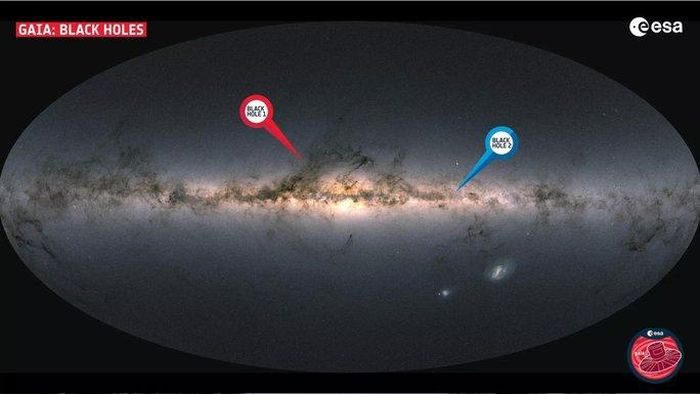Two black holes have been discovered lurking in the backyard of Earth, located just 1,560 and 3,800 light-years away, representing a type that astronomers have never seen before.
The black holes are named Gaia BH1 and Gaia BH2, discovered from data collected by the Gaia spacecraft operated by the European Space Agency (ESA).
According to Space, Gaia BH1 is located 1,560 light-years away in the direction of the constellation Ophiuchus, while Gaia BH2 is 3,800 light-years away in the direction of the constellation Sagittarius, within a region referred to as the “backyard of Earth,” an area that most telescopes do not focus on.
This marks a record proximity for black holes discovered around Earth.

Two newly discovered black holes – (Photo: ESA).
These black holes belong to a stellar system that is completely contrasting to our own. Surrounding our Sun are eight planets and a myriad of other celestial bodies, many of which could potentially harbor life, including our lush, populated Earth.
However, around a star similar to ours in the constellation Ophiuchus, there exist only the aforementioned black holes, forming a ghostly and deadly binary stellar system.
The lead researcher Kareem E-Badry, who works at both the Harvard-Smithsonian Center for Astrophysics (USA) and the Max Planck Institute for Astronomy (Germany), stated: “What makes this new group of black holes unique is that they are far from their companion stars.”
Stellar-mass black holes, like Gaia BH1 and Gaia BH2, can accompany a star and form a luminous system in X-ray radiation during observations.
They are typically quite close to each other and interact, with the black hole gradually eroding its companion star, which causes the system to emit light.
However, these two black holes are distant and completely dark, as the gravitational effects they have on their companions do not help them shine. The nature of how these strangely distant pairs exist remains unexplained.
Scientists hope that answers will be found as more similar systems emerge, a challenging task since these dark black holes are very difficult to observe – which is why they have successfully remained hidden despite being so close to Earth.
The largest types of black holes are supermassive black holes located at the centers of galaxies. For example, the black hole Sagittarius A* at the center of the Milky Way galaxy has a mass equivalent to 4 million Suns.

















































